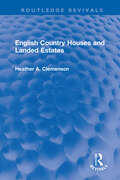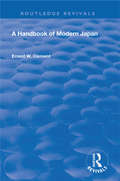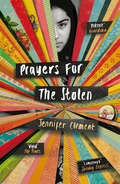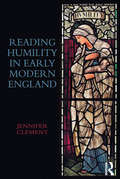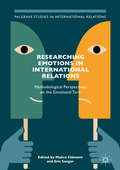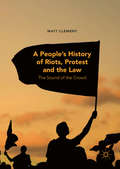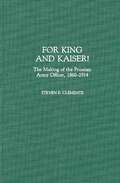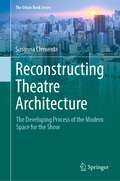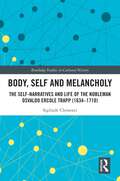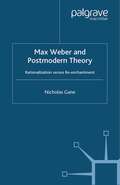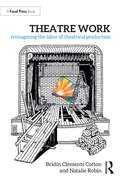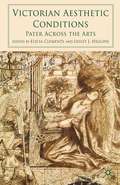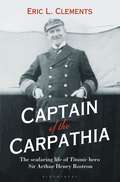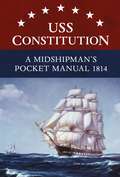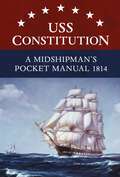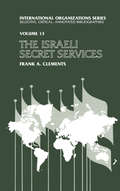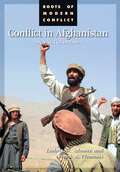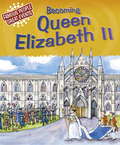- Table View
- List View
English Country Houses and Landed Estates (Routledge Revivals)
by Heather ClemensonOriginally published in 1982, and based on extensive research in estates’ archives, this book outlines the changing fate of the 500 largest estates in England over the centuries. It examines estates in their heyday and looks at their changing role as they declined in the twentieth century, showing how some estates have survived and describing the differing uses to which country houses have been put.
Revival: A Handbook of Modern Japan (Routledge Revivals)
by Ernest W. ClementIn this book the author has intended to portray Japan as he finds it rather than as it was in the past. However, the past is not ignored as it would be both foolish and futile. It is noted whilst there are no parts of Japan, and very few of her people, entirely unaffected by the new civilization, yet there are still some segments which are comparatively unchanged by the new ideas and ideals. It is observed that although those who have been least affected by the changes are more in number than those who have been most influenced by the change, yet the latter are much more active and powerful than the former.
Revival: A Handbook of Modern Japan (Routledge Revivals)
by Ernest W. ClementIn this book the author has intended to portray Japan as he finds it rather than as it was in the past. However, the past is not ignored as it would be both foolish and futile. It is noted whilst there are no parts of Japan, and very few of her people, entirely unaffected by the new civilization, yet there are still some segments which are comparatively unchanged by the new ideas and ideals. It is observed that although those who have been least affected by the changes are more in number than those who have been most influenced by the change, yet the latter are much more active and powerful than the former.
Prayers for the Stolen
by Jennifer Clement‘Now we make you ugly,’ my mother said. ‘The best thing you can be in Mexico is an ugly girl.’On the mountainside in rural Mexico where Ladydi lives, being a girl is dangerous. Especially a pretty one. If the Narcos hear there is a pretty girl on the mountain, they steal her. So when the black SUVs roll into town, Ladydi and her friends hide in the warren of holes scattered across the mountain, safely out of sight. Because the stolen girls don’t come back.Ladydi is determined to get out, to find a life that offers more than just the struggle to survive. But she soon finds that the drug cartels have eyes everywhere, and the cities are no safer than the mountains.
Reading Humility in Early Modern England
by Jennifer ClementWhile humility is not especially valued in modern Western culture, Jennifer Clement argues here, it is central to sixteenth- and seventeenth-century understandings of Christian faith and behavior, and is vital to early modern concepts of the self. As this study shows, early modern literary engagements with humility link it to self-knowledge through the practice of right reading, and make humility foundational to any proper understanding of human agency. Yet humility has received little critical interest, and has often been misunderstood as a false virtue that engenders only self-abjection. This study offers an overview of various ways in which humility is discussed, deployed, or resisted in early modern texts ranging from the explicitly religious and autobiographical prose of Katherine Parr and John Donne, to the more politically motivated prose of Queen Elizabeth I and the seventeenth-century reformer and radical Thomas Tryon. As part of the wider 'turn to religion' in early modern studies, this study seeks to complicate our understanding of a mainstream early modern virtue, and to problematize a mode of critical analysis that assumes agency is always defined by resistance.
Reading Humility in Early Modern England
by Jennifer ClementWhile humility is not especially valued in modern Western culture, Jennifer Clement argues here, it is central to sixteenth- and seventeenth-century understandings of Christian faith and behavior, and is vital to early modern concepts of the self. As this study shows, early modern literary engagements with humility link it to self-knowledge through the practice of right reading, and make humility foundational to any proper understanding of human agency. Yet humility has received little critical interest, and has often been misunderstood as a false virtue that engenders only self-abjection. This study offers an overview of various ways in which humility is discussed, deployed, or resisted in early modern texts ranging from the explicitly religious and autobiographical prose of Katherine Parr and John Donne, to the more politically motivated prose of Queen Elizabeth I and the seventeenth-century reformer and radical Thomas Tryon. As part of the wider 'turn to religion' in early modern studies, this study seeks to complicate our understanding of a mainstream early modern virtue, and to problematize a mode of critical analysis that assumes agency is always defined by resistance.
Researching Emotions in International Relations: Methodological Perspectives on the Emotional Turn
by Maéva Clément Eric SangarThis edited volume is the first to discuss the methodological implications of the ‘emotional turn’ in International Relations. While emotions have become of increasing interest to IR theory, methodological challenges have yet to receive proper attention. Acknowledging the pluralityof ontological positions, concepts and theories about the role of emotions in world politics, this volume presents and discusses various ways to research emotions empirically. Based on concrete research projects, the chapters demonstrate how social-scientific and humanitiesoriented methodological approaches can be successfully adapted to the study of emotions in IR. The volume covers a diverse set of both well-established and innovative methods, including discourse analysis, ethnography, narrative, and visual analysis. Through a hands-on approach, each chapter sheds light on practical challenges and opportunities, as well as lessons learnt for future research. The volume is an invaluable resource for advanced graduate and postgraduate students as well as scholars interested in developing their own empirical research on the role of emotions.
Researching Emotions in International Relations: Methodological Perspectives on the Emotional Turn
by Maéva Clément Eric SangarThis edited volume is the first to discuss the methodological implications of the ‘emotional turn’ in International Relations. While emotions have become of increasing interest to IR theory, methodological challenges have yet to receive proper attention. Acknowledging the pluralityof ontological positions, concepts and theories about the role of emotions in world politics, this volume presents and discusses various ways to research emotions empirically. Based on concrete research projects, the chapters demonstrate how social-scientific and humanitiesoriented methodological approaches can be successfully adapted to the study of emotions in IR. The volume covers a diverse set of both well-established and innovative methods, including discourse analysis, ethnography, narrative, and visual analysis. Through a hands-on approach, each chapter sheds light on practical challenges and opportunities, as well as lessons learnt for future research. The volume is an invaluable resource for advanced graduate and postgraduate students as well as scholars interested in developing their own empirical research on the role of emotions.
A People’s History of Riots, Protest and the Law: The Sound of the Crowd
by Matt ClementThis book examines how movements from below pose challenges to the status quo. The 2010s have seen an explosion of protest movements, sometimes characterised as riots by governments and the media. But these are not new phenomena, rather reflecting thousands of years of conflict between different social classes. Beginning with struggles for democracy and control of the state in Athens and ancient Rome, this book traces the common threads of resistance through the Middle Ages in Europe and into the modern age. As classes change so does the composition of the protestors and the goals of their movements; the one common factor being how groups can mobilise to resist unbearable oppression, thereby developing a crowd consciousness that widens their political horizons and demonstrates the possibility of overthrowing the existing order. To appreciate the roots and motivations of these so-called deviants the author argues that we need to listen to the sound of the crowd. This book will be of interest to researchers of social movements, protests and riots across sociology, history and international relations.
For King and Kaiser!: The Making of the Prussian Army Officer, 1860-1914 (Contributions in Military Studies)
by Steven E. ClementeSteven Clemente describes how conservative traditions and artistocratic values were preserved in the selection and training of German army officers prior to World War I despite changing times and the influx of many middle-class recruits into the army. He demonstrates how right thinking and service to the King and the Kaiser were the basis for Prussian officer education in the period from 1860 to 1914.The history provides considerable detail about German secondary school education, the selection of officers, the curriculum, and life in the cadet and war schools, the life of a subaltern, and the education of the Prussian War Academy. The book concludes with an analysis of the attitudes and loyalties of the officers that entered World War I. Students of European history and military affairs will find this study one that raises a number of provocative questions about German performance in World War I and in subsequent years.
Reconstructing Theatre Architecture: The Developing Process of the Modern Space for the Show (The Urban Book Series)
by Susanna ClementeThe study is aimed at reconstructing the historical process at the base of any significant theatre architecture. The modern space for the show is no longer intended as a direct derivation from classical types, but as a product of the transformation of the urban fabric in our cities. The research was conducted at the academies, state and municipal historical archives of numerous towns, in particular Rome, Milan, Mantua, Ferrara, Venice, London and Prague. All images are original. The work also includes the list of about 700 major Italian historical theatres.
Body, Self and Melancholy: The Self-Narratives and Life of the Nobleman Osvaldo Ercole Trapp (1634-1710) (Routledge Studies in Cultural History)
by Siglinde ClementiThis book addresses early modern concepts of the body and the self – focussing on three self-narratives authored by the nobleman Osvaldo Ercole Trapp (1634–1710), a body description from head to foot, autobiographical writings, and a brief chronicle of the House of Trapp-Caldonazzo. Approaching the complex theme of the question of the early modern self and the historical body, this book intertwines consistent contextualisation and historicisation of self-interpretation and biography. This is done in three steps: first, the content and function of these self-narratives are analysed with reference to current research on early modern self-narratives. In a second step, the life and family history of Osvaldo Ercole Trapp are examined from a microhistorical perspective and placed within the context of the early modern history of Tyrol’s nobility. A third step then goes into detail on individual contexts and discourses that refine one’s comprehension of these self-narratives: noble masculinity; family, house and line; theories of procreation and education; body experience and body images. It combines textual analysis, historical anthropology with a strong gender-historical perspective, microhistory and the history of the body as a history of experience and discourse. With this approach, the study makes an innovative contribution to early modern studies on self-narratives, social history of early modern nobility and the history of the body as the history of experience and discourse. This volume will be of interest to students and scholars alike interested in intellectual, social and cultural history.
Body, Self and Melancholy: The Self-Narratives and Life of the Nobleman Osvaldo Ercole Trapp (1634-1710) (Routledge Studies in Cultural History)
by Siglinde ClementiThis book addresses early modern concepts of the body and the self – focussing on three self-narratives authored by the nobleman Osvaldo Ercole Trapp (1634–1710), a body description from head to foot, autobiographical writings, and a brief chronicle of the House of Trapp-Caldonazzo. Approaching the complex theme of the question of the early modern self and the historical body, this book intertwines consistent contextualisation and historicisation of self-interpretation and biography. This is done in three steps: first, the content and function of these self-narratives are analysed with reference to current research on early modern self-narratives. In a second step, the life and family history of Osvaldo Ercole Trapp are examined from a microhistorical perspective and placed within the context of the early modern history of Tyrol’s nobility. A third step then goes into detail on individual contexts and discourses that refine one’s comprehension of these self-narratives: noble masculinity; family, house and line; theories of procreation and education; body experience and body images. It combines textual analysis, historical anthropology with a strong gender-historical perspective, microhistory and the history of the body as a history of experience and discourse. With this approach, the study makes an innovative contribution to early modern studies on self-narratives, social history of early modern nobility and the history of the body as the history of experience and discourse. This volume will be of interest to students and scholars alike interested in intellectual, social and cultural history.
Russian Masculinities in History and Culture
by B. Clements R. Friedman D. HealeyFrom the romantic liaisons of Peter the Great to the birth of the Russian 'queen', this collection of essays presents recent research from the new field of Russian masculinity studies. Peasant patriarchs, aristocratic dandies, anxious young bureaucrats, workers in search of father figures, heroic warriors, promiscuous bathhouse attendants and vodka-soaked athletic stars populate this volume. Its essays take as a starting point the notion that masculinity, like femininity, has a history.
Theatre Work: Reimagining the Labor of Theatrical Production
by Brídín Clements Cotton Natalie RobinTheatre Work: Reimagining the Labor of Theatrical Production investigates both the history and current realities of life and work in professional theatrical production in the United States and explores labor practices that are equitable, accessible, and sustainable.In this book, Brídín Clements Cotton and Natalie Robin investigate the question of artmaking, specifically theatrical production, as work. When the art is the work, how do employers navigate the balance between creative freedom and these equitable, accessible, and sustainable personnel processes? Do theatrical production operations value the worker? Through data analyses, worker narratives, and analogues to the evolving gig economy, Theatre Work questions everything about theatrical production work – including our shared history, ways of operating, and assumptions about how theatre is made – and considers what might happen if the American Theatre was reborn in an entirely new form.Written for members of the theatrical production workplace, leaders of theatrical institutions and productions, labor organizers, and industry union leaders, Theatre Work: Reimagining the Labor of Theatrical Production speaks to the ways that employers and workers can reimagine how we work.
Theatre Work: Reimagining the Labor of Theatrical Production
by Brídín Clements Cotton Natalie RobinTheatre Work: Reimagining the Labor of Theatrical Production investigates both the history and current realities of life and work in professional theatrical production in the United States and explores labor practices that are equitable, accessible, and sustainable.In this book, Brídín Clements Cotton and Natalie Robin investigate the question of artmaking, specifically theatrical production, as work. When the art is the work, how do employers navigate the balance between creative freedom and these equitable, accessible, and sustainable personnel processes? Do theatrical production operations value the worker? Through data analyses, worker narratives, and analogues to the evolving gig economy, Theatre Work questions everything about theatrical production work – including our shared history, ways of operating, and assumptions about how theatre is made – and considers what might happen if the American Theatre was reborn in an entirely new form.Written for members of the theatrical production workplace, leaders of theatrical institutions and productions, labor organizers, and industry union leaders, Theatre Work: Reimagining the Labor of Theatrical Production speaks to the ways that employers and workers can reimagine how we work.
Victorian Aesthetic Conditions: Pater Across the Arts
by E. Clements L. HigginsThe multidisciplinary aesthetics of Walter Pater, the nineteenth century's most provocative critic, are explored by an international team of scholars. 'True aesthetic criticism' takes place working across the arts, Pater insists: acknowledging the differences between media, but seeking possibilities of interconnection.
Captain of the Carpathia: The seafaring life of Titanic hero Sir Arthur Henry Rostron
by Eric L. ClementsResponding to Titanic's distress calls in the early hours of 15 April 1912, Captain Arthur Rostron raced the Cunard liner Carpathia to the scene of the sinking, rescued the seven hundred survivors of the world's most famous shipwreck and then carried them to safety at New York. After twenty-five years at sea, the competence and compassion Rostron displayed during the rescue made him a hero on two continents and presaged his subsequent achievements.During the First World War he participated in the invasion of Gallipoli and commanded Cunard's Mauretania as a hospital ship in the Mediterranean and a troop transport in the Atlantic. As her longest-serving master he commanded that legendary vessel in transatlantic passenger service through most of the 1920s. Rostron retired in 1931 as the most esteemed master mariner of his era, celebrated for the Titanic rescue, decorated for his war service, and knighted for his contributions to British seafaring.This account uses newspaper reports, company records, government documents, contemporary publications and memoirs to recount Rostron's seafaring life from his first voyage as an apprentice rounding Cape Horn in sail to his retirement forty-four years later as commodore of the Cunard Line. Set within the context of his times and featuring particulars of the ships in which he served and commanded, this is the first comprehensive biography of Arthur Rostron before, during and after his year as captain of the Carpathia.
Captain of the Carpathia: The seafaring life of Titanic hero Sir Arthur Henry Rostron
by Eric L. ClementsResponding to Titanic's distress calls in the early hours of 15 April 1912, Captain Arthur Rostron raced the Cunard liner Carpathia to the scene of the sinking, rescued the seven hundred survivors of the world's most famous shipwreck and then carried them to safety at New York. After twenty-five years at sea, the competence and compassion Rostron displayed during the rescue made him a hero on two continents and presaged his subsequent achievements.During the First World War he participated in the invasion of Gallipoli and commanded Cunard's Mauretania as a hospital ship in the Mediterranean and a troop transport in the Atlantic. As her longest-serving master he commanded that legendary vessel in transatlantic passenger service through most of the 1920s. Rostron retired in 1931 as the most esteemed master mariner of his era, celebrated for the Titanic rescue, decorated for his war service, and knighted for his contributions to British seafaring.This account uses newspaper reports, company records, government documents, contemporary publications and memoirs to recount Rostron's seafaring life from his first voyage as an apprentice rounding Cape Horn in sail to his retirement forty-four years later as commodore of the Cunard Line. Set within the context of his times and featuring particulars of the ships in which he served and commanded, this is the first comprehensive biography of Arthur Rostron before, during and after his year as captain of the Carpathia.
USS Constitution: A Midshipman's Pocket Manual, 1814
by Eric L. ClementsLaunched in 1797, USS Constitution is a wooden-hulled, three-masted heavy frigate of the United States Navy. She is renowned for her actions during the War of 1812 against the Britain, when she captured numerous merchant ships and defeated five British warships. The battle with HMS Guerriere earned her the nickname 'Old Ironsides' and a longstanding public adoration that has repeatedly saved her from scrapping. She continued to serve as flagship in the Mediterranean and African squadrons, and circled the world in the 1840s. Retired from active service in 1881, Constitution served as a receiving ship until designated a museum ship in 1907. Comprising a series of documents and illustrations that give information on the building of the ship, her wartime service history and life on board ship during the years of her service, this fascinating book tells the story of Old Ironsides
USS Constitution A Midshipman's Pocket Manual 1814: A Midshipman's Pocket Manual, 1814
by Eric L. ClementsLaunched in 1797, USS Constitution is a wooden-hulled, three-masted heavy frigate of the United States Navy. She is renowned for her actions during the War of 1812 against the Britain, when she captured numerous merchant ships and defeated five British warships. The battle with HMS Guerriere earned her the nickname 'Old Ironsides' and a longstanding public adoration that has repeatedly saved her from scrapping. She continued to serve as flagship in the Mediterranean and African squadrons, and circled the world in the 1840s. Retired from active service in 1881, Constitution served as a receiving ship until designated a museum ship in 1907. Comprising a series of documents and illustrations that give information on the building of the ship, her wartime service history and life on board ship during the years of her service, this fascinating book tells the story of Old Ironsides
Israeli Secret Services (International Organizations Ser. #Vol. 13)
by Frank ClementsThe Israeli Institute for Intelligence and Special Services, the Mossad, is pobably the best known of the world's intelligence services, one of the most sespected and, certainly, one of the most intriguing. However, despite its fame, the available literature, other than Hebrew, is limited and scattered amongst a variety of subject areas because the tentacles of the Mossad are similarly varied. The aim of this volume is to document the range of English language material available on «f Mossad from its pre-official origins in Europe during the Second World War to e present period of the Middle East peace process. The organization had its origins in the aftermath of the Holocaust, being the agency responsible for organizing the illegal Jewish immigration into Palestine before becoming officially constituted in 1951. Since its formation the Mossad has been intimately involved in each of the significant events in Israel's history, including actions against its Arab neighbors, the hunting of wanted Nazis, spectacular actions such as the raid on Entebbe to free the hostages, counter-terrorist activities, and high technology espionage against friend and foe alike. This bibliography will be of interest to researchers covering intelligence activities and to students, scholars, and librarians interested in the history of Israel and its relations with its Arab neighbors. The early material on the Mossad will also be of special concern to students of the Holocaust and its aftermath.
Israeli Secret Services
by Frank ClementsThe Israeli Institute for Intelligence and Special Services, the Mossad, is pobably the best known of the world's intelligence services, one of the most sespected and, certainly, one of the most intriguing. However, despite its fame, the available literature, other than Hebrew, is limited and scattered amongst a variety of subject areas because the tentacles of the Mossad are similarly varied. The aim of this volume is to document the range of English language material available on «f Mossad from its pre-official origins in Europe during the Second World War to e present period of the Middle East peace process. The organization had its origins in the aftermath of the Holocaust, being the agency responsible for organizing the illegal Jewish immigration into Palestine before becoming officially constituted in 1951. Since its formation the Mossad has been intimately involved in each of the significant events in Israel's history, including actions against its Arab neighbors, the hunting of wanted Nazis, spectacular actions such as the raid on Entebbe to free the hostages, counter-terrorist activities, and high technology espionage against friend and foe alike. This bibliography will be of interest to researchers covering intelligence activities and to students, scholars, and librarians interested in the history of Israel and its relations with its Arab neighbors. The early material on the Mossad will also be of special concern to students of the Holocaust and its aftermath.
Conflict in Afghanistan: An Encyclopedia (Roots of Modern Conflict)
by Frank A. Clements Ludwig W. AdamecA comprehensive A–Z study of the history of conflict in Afghanistan from 1747 to the present.This authoritative, clearly written volume covers all aspects of the conflicts that have taken place in Afghanistan from 1747 to the present. Conflict in Afghanistan provides the reader with a historical overview of hostilities in Afghanistan and discusses their causes, history, and impact on Afghan society and on regional and international relations.A single A–Z section covers the three main eras in Afghanistan's history: the period from 1747, when Afghanistan first emerged as a "unified" state; the Soviet era (1979–1989), which saw the overthrow of the monarchy, the declaration of the Republic, and the rise of the Mujahideen; and the post-Soviet period, which brought civil war, the rise of the Taliban, and finally the events of September 11 and the War on Terrorism, both of which receive special attention.
Becoming Queen Elizabeth II: Famous People, Great Events (Famous People, Great Events #10)
by Gillian ClementsWhen Elizabeth was born, no-one imagined that she would one day be Queen - so how did this happen? Read all about Queen Elizabeth II's story in this engaging picture book.This book is part of a series of picture books, Famous People, Great Events, which are suitable for ages 6-12. They tell the stories of famous men and women and great events in history. Written by successful authors, they are enjoyable reads which are packed with facts and colourful illustrations.Each book includes a timeline of key dates, a quiz and index.
